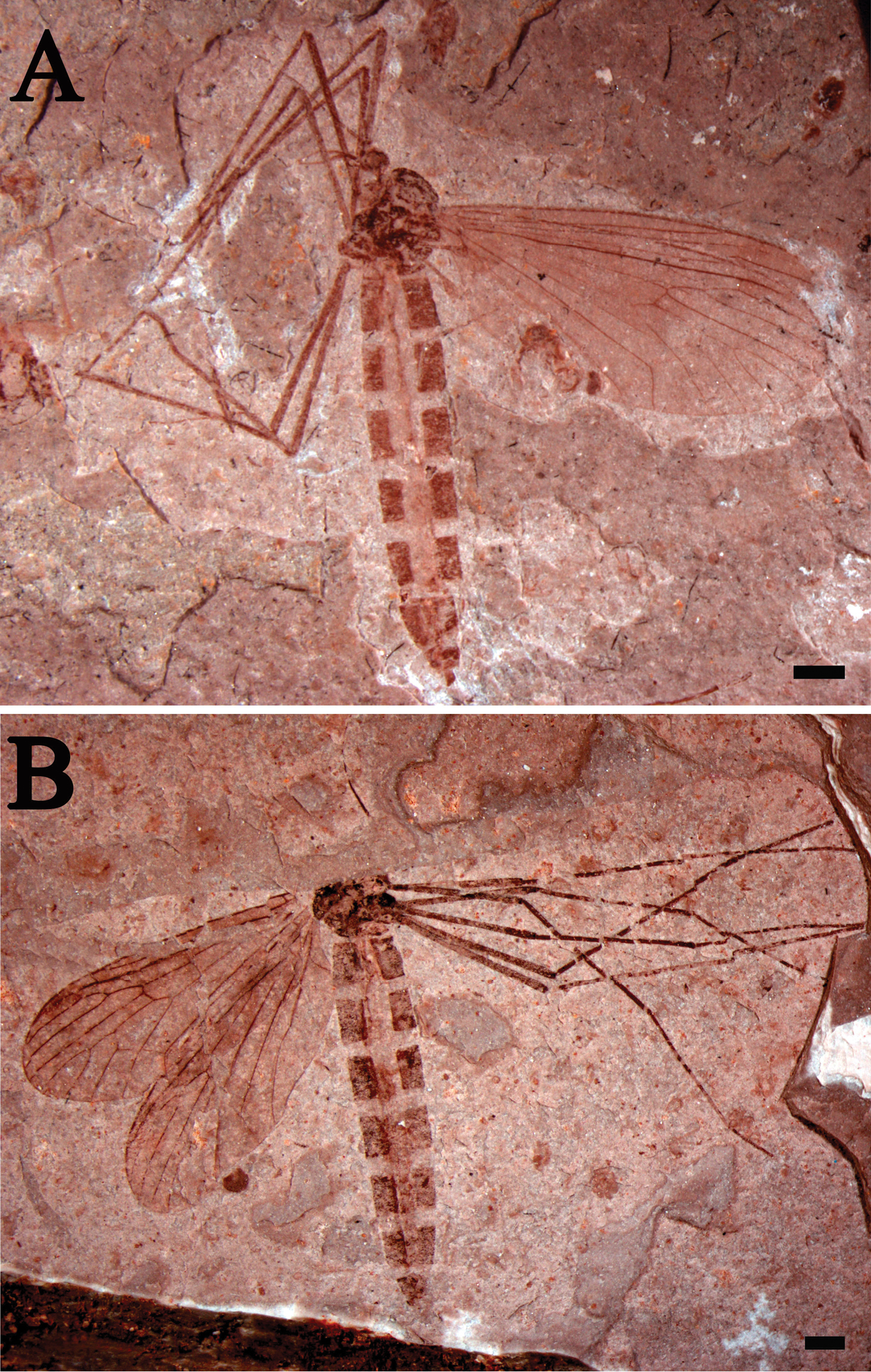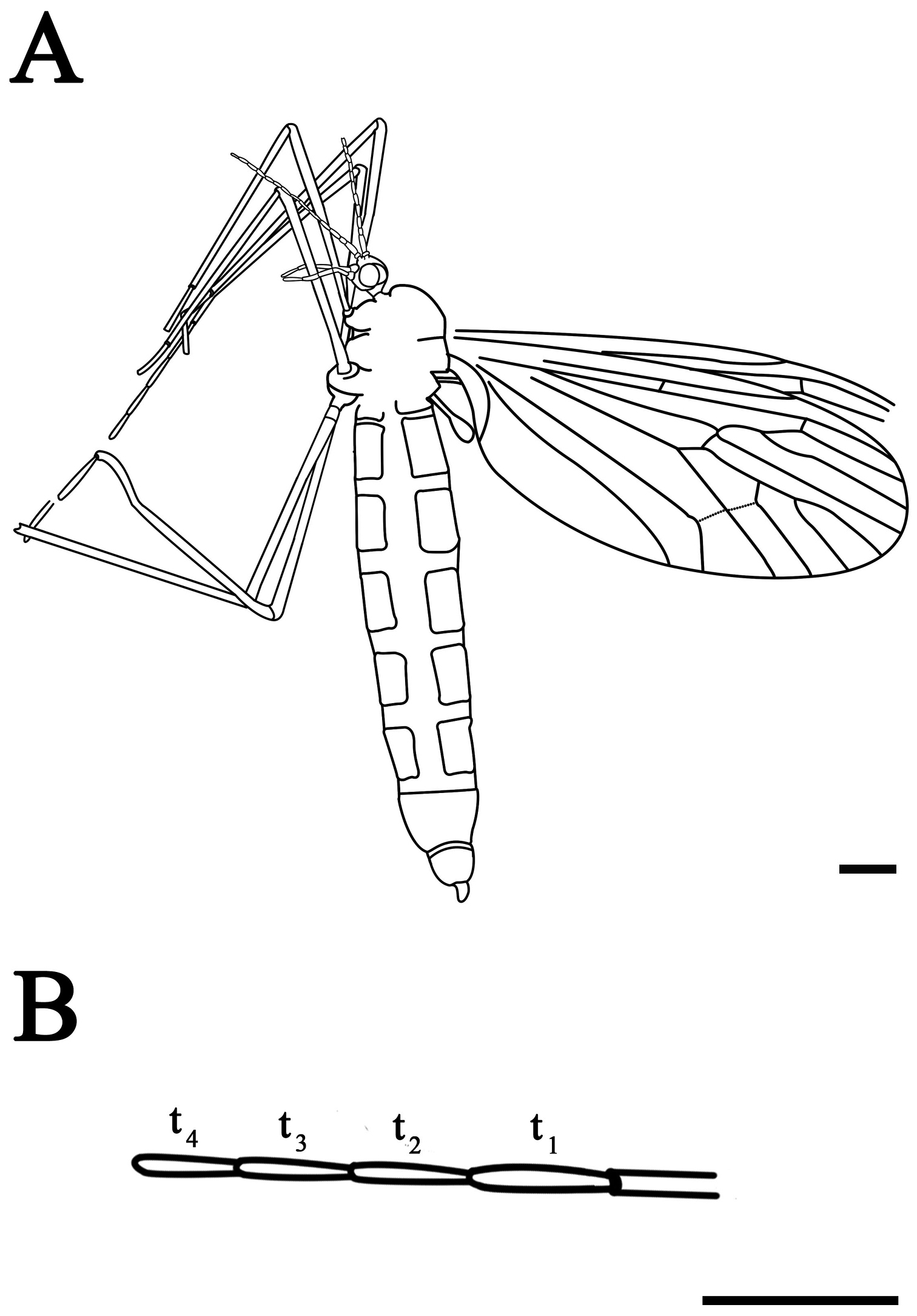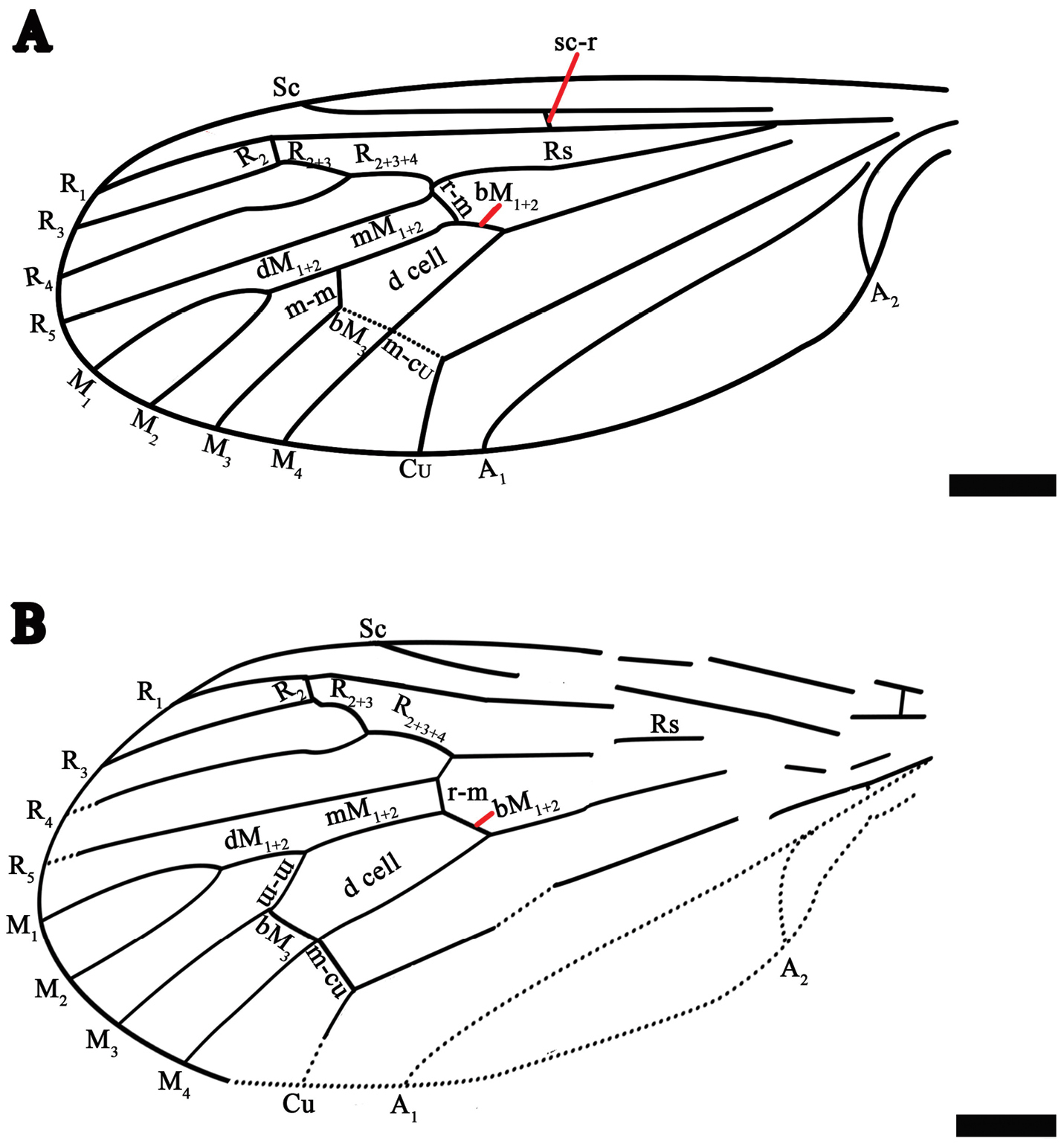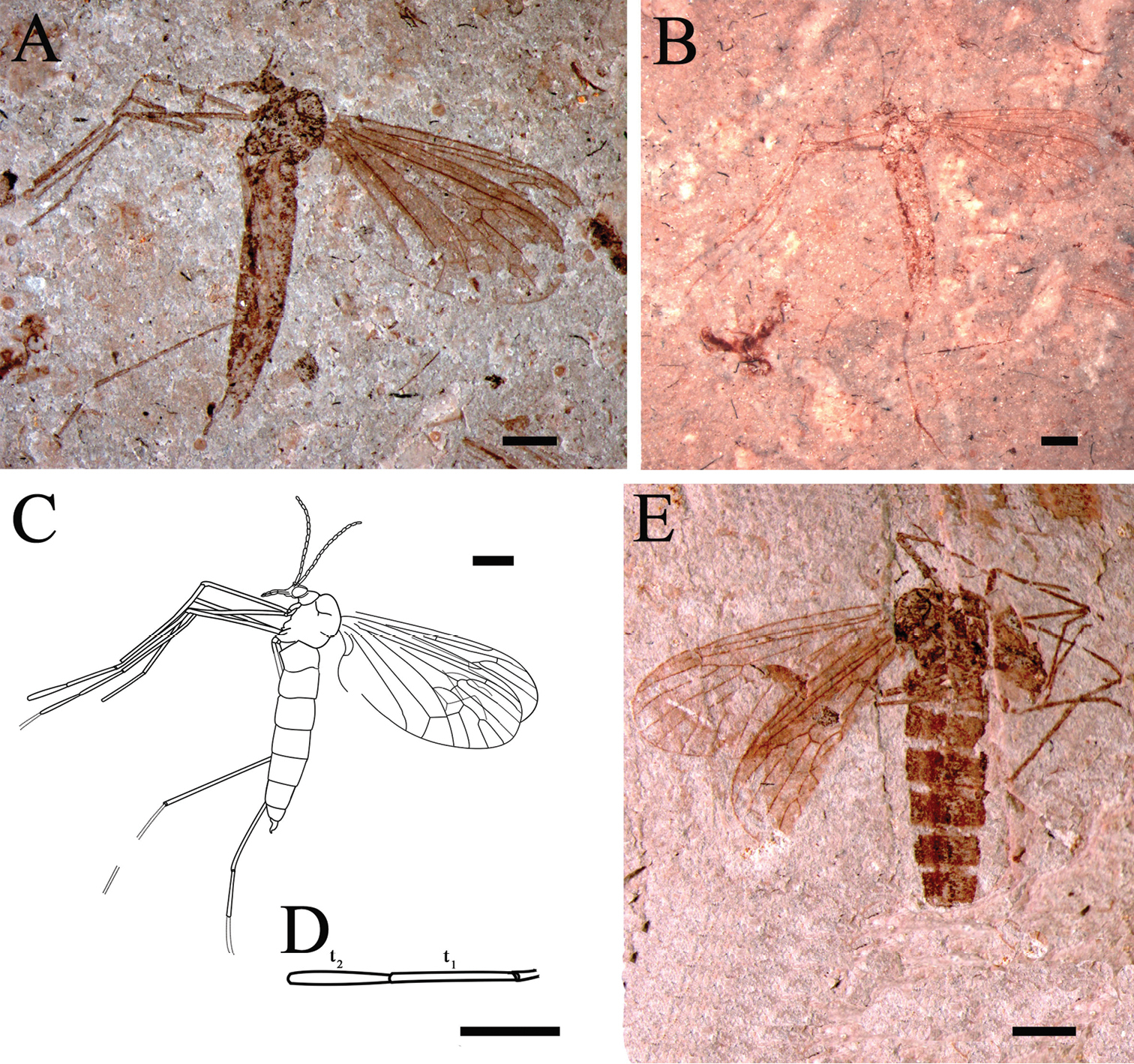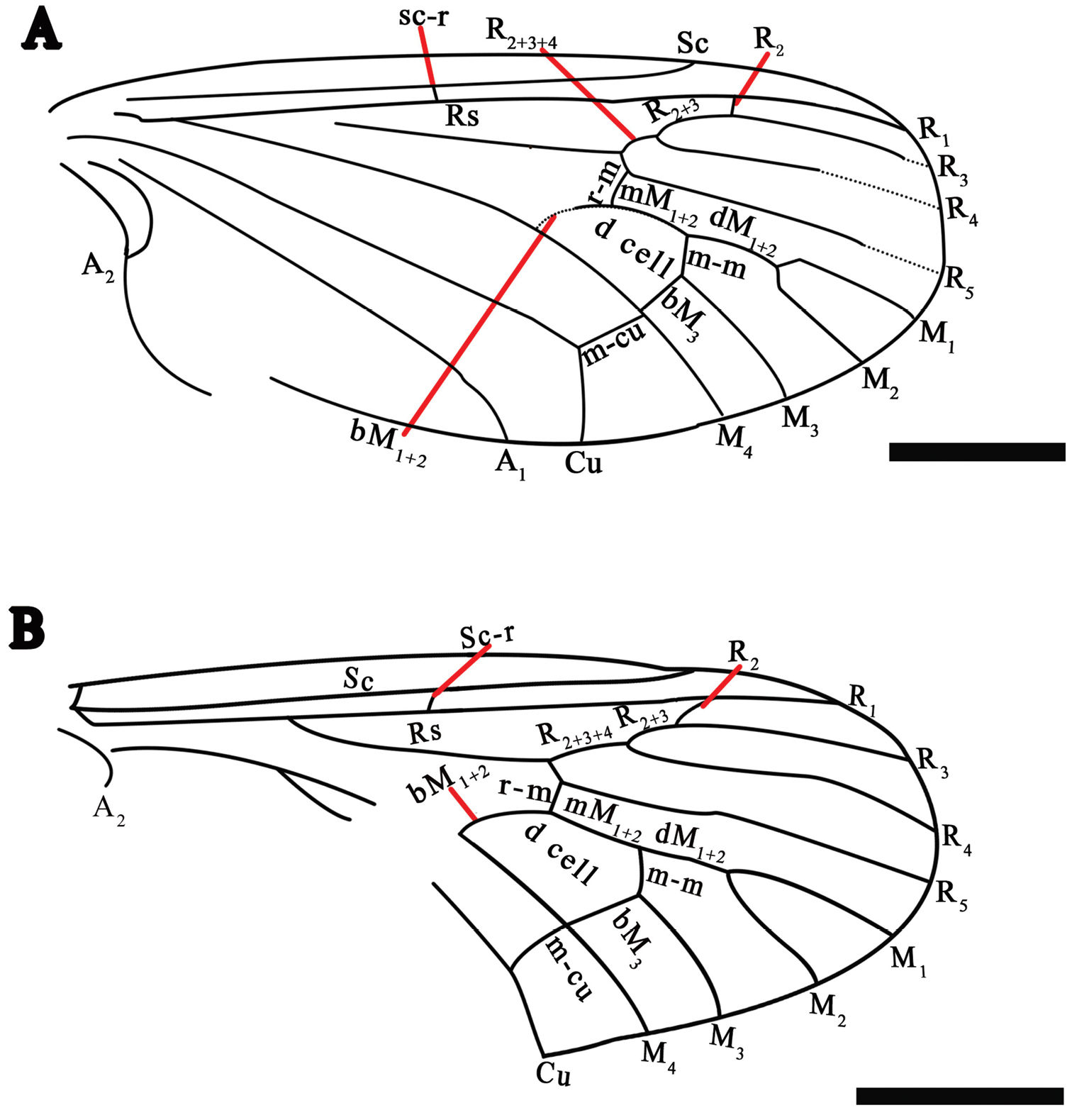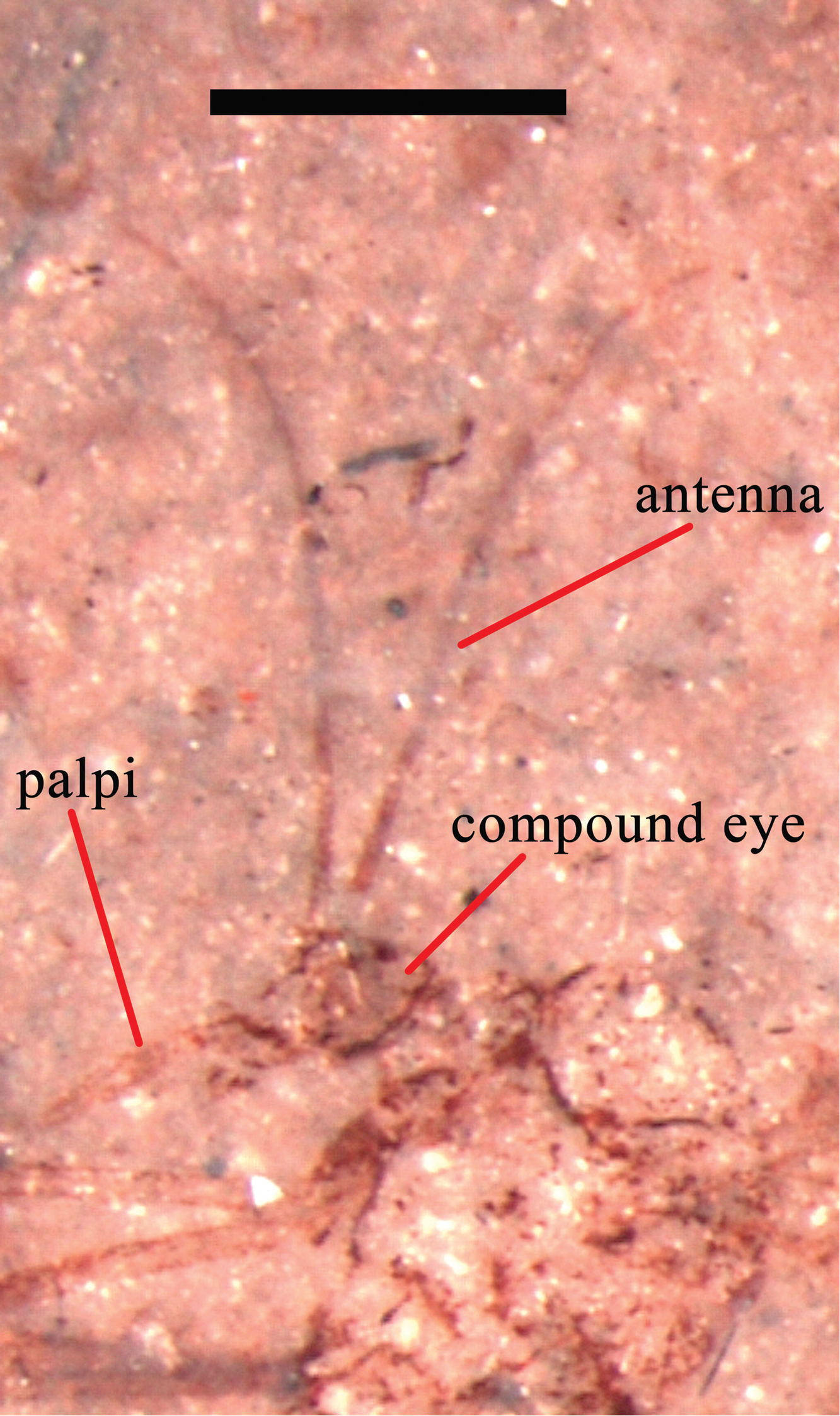






Citation: Dong F, Shih C-K, Ren D (2014) Two new species of Trichoceridae from the Middle Jurassic Jiulongshan Formation of Inner Mongolia, China. ZooKeys 411: 145–160. doi: 10.3897/zookeys.411.6858
Two new species, Eotrichocera (Archaeotrichocera) longensis sp. n. and Eotrichocera (Archaeotrichocera) amabilis sp. n. of Trichoceridae are described based on a combination of the following characters: Sc ending proximad of the forking of R2, shape of d cell and A2 rather short and bending sharply toward posterior margin. These fossil specimens were collected from the Middle Jurassic Jiulongshan Formation of Daohugou in Inner Mongolia, China.
Diptera, Eotrichocera, Archaeotrichocera, Fossil, Daohugou
Trichoceridae is a family of medium-sized dipterans, commonly called winter crane flies,
There are 77 species of fossil and amber trichocerids, which have been assigned into three subfamilies: Trichocerinae, Paracladurinae and Kovalevinae; and twelve genera: Cladoneura Scudder, 1894; Eotrichocera Kalugina, 1985; Rasnitsynina Krzemińska, Krzemiński & Dahl, 2009; Mailotrichocera Kalugina, 1985; Paleotrichocera Kalugina, 1986; Karatina Krzemińska, Krzemiński, Dahl & Lukashevich, 2009; Trichocera Meigen, 1803; Tanyochoreta Zhang, 2006; Zherikhinina Krzemińska, Krzemiński & Dahl, 2009; Undaya Krzemińska, Krzemiński & Dahl, 2009; Kovaleva Krzemińska, Krzemiński & Dahl, 2009; Paracladura Brunetti, 1911 (
Among them, there are eight species in three genera described from the Daohugou locality of China: Eotrichocera (Archaeotrichocera) ephemera Zhang, 2006; Tanyochoreta integera Zhang, 2006; Tanyochoreta chifengica Zhang, 2006; Tanyochoreta (Sinotrichocera) parva Zhang, 2006; Eotrichocera (Archaeotrichocera) conica Krzemińska, Krzemiński & Ren, 2009; Eotrichocera (Archaeotrichocera) rara Krzemińska, Krzemiński & Ren, 2009; Eotrichocera (Archaeotrichocera) spatiosa Liu, Shih & Ren, 2012 and Zherikhinina reni Krzemińska, Krzemiński & Dahl, 2009.
Furthermore, Sinotrichocera Zhang, 2006 has been changed as a subgenus belonging to Tanyochoreta; Oligotrichocera Dahl, 1971 as a subgenus belonging to Trichocera Podenas, 2001; Trichonomites Kalugina, 1986 and Paleotrichocera Kalugina, 1986 are synonymized (
Fossil species of Trichoceridae Kertész, 1902.
| Genus | Species | Author(s) | Date | Age | Locality |
|---|---|---|---|---|---|
| Cladoneura | Cladoneura willistoni | Scudder | 1894 | Lower Oligocene | Florissant, USA |
| Eotrichocera (Archaeotrichocera) | Eotrichocera (Archaeotrichocera) ephemera | Zhang | 2006 | Middle Jurassic | Daohugou, China |
| Eotrichocera (Archaeotrichocera) conica | Krzemińska, Krzemiński & Ren | 2009a | Middle Jurassic | Daohugou, China | |
| Eotrichocera (Archaeotrichocera) rara | Krzemińska, Krzemiński & Ren | 2009a | Lower Cretaceous | Kempendyay, Russia | |
| Eotrichocera (Archaeotrichocera) spatiosa | Liu, Shih & Ren | 2012a | Middle Jurassic | Daohugou, China | |
| Eotrichocera (Eotrichocera) | Eotrichocera (Eotrichocera) christinae | Kalugina | 1985 | Lower Jurassic or earlier Middle Jurassic | Novospasskoe, Russia |
| Karatina | Karatina longipes | Rohdendorf | 1964 | Upper Jurassic | Karatau, Kazakhstan |
| Karatina explorans | Krzemińska, Krzemiński, Dahl & Lukashevich | 2009a | Lower Cretaceous | Baissa, Russia | |
| Karatina pellita | Krzemińska, Krzemiński, Dahl & Lukashevich | 2009a | Upper Jurassic | Karatau, Kazakhstan | |
| Kovaleva (Kovaleva) | Kovaleva (Kovaleva) fragmentosa | Krzemińska, Krzemiński & Dahl | 2009a | Jurassic/Cretaceous boundary | Unda and Daya, E. Transbaikalia |
| Kovaleva (Kovaleva) hirsuta | Krzemińska, Krzemiński & Dahl | 2009a | Jurassic/Cretaceous boundary | Daya, E. Transbaikalia | |
| Kovaleva (Kovaleva) obscura | Krzemińska, Krzemiński & Dahl | 2009a | Jurassic/Cretaceous boundary | Daya, Unda and Shevia, E. Transbaikalia | |
| Kovaleva (Kovaleva) sheviae | Krzemińska, Krzemiński & Dahl | 2009a | Jurassic/Cretaceous boundary | Shevia, E. Transbaikalia | |
| Kovaleva (Kovaleva) volodii | Krzemińska, Krzemiński & Dahl | 2009a | Jurassic/Cretaceous boundary | Daya, E. Transbaikalia | |
| Kovaleva (Vladimirevna) | Kovaleva (Vladimirevna) mirabilis | Krzemińska, Krzemiński & Dahl | 2009a | Jurassic/Cretaceous boundary | Daya, E. Transbaikalia |
| Mailotrichocera | Mailotrichocera jurassica | Kalugina | 1985 | Uppermost middle or earliest Upper Jurassic | Uda, E. Transbaikalia |
| Mailotrichocera gracilis | Krzemińska, Krzemiński & Dahl | 2009a | Jurassic/Cretaceous boundary | Daya, Unda and Shevia, E Transbaikalia | |
| Mailotrichocera mikereichi | Krzemińska, Krzemiński & Ansorge | 2009a | Lower Jurassic | Dobbertin, Germany; Grimmen, Germany | |
| Mailotrichocera ovifera | Krzemińska, Krzemiński & Dahl | 2009a | Jurassic/ Cretaceous boundary | Unda, E. Transbaikalia | |
| Mailotrichocera prisca | Krzemińska, Krzemiński & Dahl | 2009a | Jurassic/Cretaceous boundary | Unda and Shevia, E. Transbaikalia | |
| Mailotrichocera sukachevae | Krzemińska, Krzemiński & Dahl | 2009a | Jurassic/Cretaceous boundary | Unda, E Transbaikalia | |
| Mailotrichocera variabilis | Krzemińska, Krzemiński & Ansorge | 2009a | Lower Jurassic | Dobbertin, Germany; Grimmen, Germany | |
| Mailotrichocera zessini | Krzemińska, Krzemiński & Ansorge | 2009a | Lower Jurassic | Grimmen, Germany | |
| Paleotrichocera | Paleotrichocera mongolica | Kalugina | 1986 | Lower Cretaceous | Gurvan Erenyi Nuru, Mongolia |
| Paracladura | Paracladura caucasiana | Krzemińska, Krzemiński & Dahl | 2009a | Middle Miocene | Stavropol, Caucasus |
| Rasnitsynina | Rasnitsynina collecta | Krzemińska, Krzemiński & Dahl | 2009a | Jurassic/Cretaceous boundary | Shevia, E. Transbaikalia |
| Rasnitsynina minae | Krzemińska, Krzemiński & Dahl | 2009a | Jurassic/Cretaceous boundary | Shevia and Daya, E Transbaikalia | |
| Tanyochoreta (Sinotrichocera) | Tanyochoreta (Sinotrichocera) parva | Zhang | 2006 | Middle Jurassic | Daohugou, China |
| Tanyochoreta (Tanyochoreta) | Tanyochoreta (Tanyochoreta) chifengica | Zhang | 2006 | Middle Jurassic | Daohugou, China |
| Tanyochoreta (Tanyochoreta) integera | Zhang | 2006 | Middle Jurassic | Daohugou, China | |
| Tanyochoreta (Trichokara) | Tanyochoreta (Trichokara) composita | Krzemińska, Krzemiński & Dahl | 2009a | Upper Jurassic | Karatau, Kazakhstan |
| Tanyochoreta (Trichokara) fracta | Krzemińska, Krzemiński & Dahl | 2009a | Upper Jurassic | Karatau, Kazakhstan | |
| Tanyochoreta (Trichokara) minuta | Krzemińska, Krzemiński & Dahl | 2009a | Upper Jurassic | Karatau, Kazakhstan | |
| Tanyochoreta (Trichokara) tenuis | Krzemińska, Krzemiński & Dahl | 2009a | Upper Jurassic | Karatau, Kazakhstan | |
| Tanyochoreta (Trichokara) zagadka | Krzemińska, Krzemiński & Dahl | 2009a | Jurassic/Cretaceous boundary | Unda, E Transbaikalia | |
| Tanyochoreta (Trichokara) zbulwami | Krzemińska, Krzemiński & Dahl | 2009a | Jurassic/Cretaceous boundary | Daya and Unda, E Transbaikalia | |
| Trichocera | Trichocera scudderi | Meunier | 1915 | Upper Oligocene | Rott, Germany |
| Trichocera miocaenica | Statz | 1934 | Upper Oligocene | Rott, Germany | |
| Trichocera antiqua | Dahl | 1971 | Upper Eocene | Baltic | |
| Trichocera primaeva | Dahl | 1971 | Upper Eocene | Baltic | |
| Trichocera fujiyamai | Gentilini | 1984 | Upper Miocene | Monte Castellaro, Italy | |
| Trichocera anbar | Podenas | 2001 | Upper Eocene | Baltic | |
| Trichocera bona | Podenas | 2001 | Upper Eocene | Baltic | |
| Trichocera cerea | Podenas | 2001 | Upper Eocene | Baltic | |
| Trichocera diluta | Podenas | 2001 | Upper Eocene | Baltic | |
| Trichocera ebenos | Podenas | 2001 | Upper Eocene | Baltic | |
| Trichocera christelae | Krzemińska, Krzemiński & Dahl | 2009a | Upper Eocene | Baltic | |
| Trichocera corami | Krzemińska, Krzemiński & Dahl | 2009a | Lower Cretaceous | Purbeck, UK | |
| Trichocera cretacea | Krzemińska, Krzemiński & Dahl | 2009a | Lower Cretaceous | Baissa, Russia | |
| Trichocera hanswerneri | Krzemińska, Krzemiński & Dahl | 2009a | Upper Eocene | Baltic | |
| Trichocera turgana | Krzemińska, Krzemiński & Dahl | 2009a | earlier Lower Cretaceous | Turga, E. Transbaikalia | |
| Undaya | Undaya alata | Krzemińska, Krzemiński & Dahl | 2009a | Jurassic/Cretaceous boundary | Unda and Shevia, E. Transbaikalia |
| Undaya comis | Krzemińska, Krzemiński & Dahl | 2009a | Jurassic/Cretaceous boundary | Unda, E. Transbaikalia | |
| Undaya gargantuina | Krzemińska, Krzemiński & Dahl | 2009a | Jurassic/Cretaceous boundary | Daya and Unda, E. Transbaikalia | |
| Undaya hilara | Krzemińska, Krzemiński & Dahl | 2009a | Jurassic/Cretaceous boundary | Unda and Shevia, E. Transbaikalia | |
| Undaya kaluginae | Krzemińska, Krzemiński & Dahl | 2009a | Jurassic/Cretaceous boundary | Daya, E. Transbaikalia | |
| Undaya lenae | Krzemińska, Krzemiński & Dahl | 2009a | Upper Jurassic | Shar-Teg, Mongolia | |
| Undaya lukashevichae | Krzemińska, Krzemiński & Dahl | 2009a | Upper Jurassic | Shar-Teg, Mongolia | |
| Undaya maxima | Krzemińska, Krzemiński & Dahl | 2009a | Lower Cretaceous | Kempendyay, Russia | |
| Undaya mitis | Krzemińska, Krzemiński & Dahl | 2009a | Jurassic/Cretaceous boundary | Daya and Unda, E. Transbaikalia | |
| Undaya molesta | Krzemińska, Krzemiński & Dahl | 2009a | Jurassic/Cretaceous boundary | Unda and Daya, E. Transbaikalia | |
| Undaya namdyriensis | Krzemińska, Krzemiński & Dahl | 2009a | Lower Cretaceous | Kempendyay, Russia | |
| Undaya parvula | Krzemińska, Krzemiński & Dahl | 2009a | Jurassic/Cretaceous boundary | Daya and Unda, E. Transbaikalia | |
| Undaya pura | Krzemińska, Krzemiński & Dahl | 2009a | Jurassic/Cretaceous boundary | Unda and Daya, E. Transbaikalia | |
| Undaya salsa | Krzemińska, Krzemiński & Dahl | 2009a | Lower Cretaceous | Kempendyay, Russia | |
| Undaya savina | Krzemińska, Krzemiński & Dahl | 2009a | Jurassic/Cretaceous boundary | Savina, E. Transbaikalia | |
| Undaya saxea | Krzemińska, Krzemiński & Dahl | 2009a | Lower Cretaceous | Kempendyay, Russia | |
| Undaya triangula | Krzemińska, Krzemiński & Dahl | 2009a | Lower Cretaceous | Kempendyay, Russia | |
| Zherikhinina | Zherikhinina itatica | Kalugina | 1985 | Middle Jurassic | Kubekovo, Russia |
| Zherikhinina alastos | Krzemińska & Lukashevich | 2009b | Upper Jurassic | Shar Teg, Mongolia | |
| Zherikhinina baissana | Krzemińska, Krzemiński & Dahl | 2009a | Lower Cretaceous | Baissa, Russia | |
| Zherikhinina bontsagana | Krzemińska, Krzemiński & Dahl | 2009a | Lower Cretaceous | Bon Tsagan, Mongolia | |
| Zherikhinina karatavica | Krzemińska, Krzemiński & Dahl | 2009a | Upper Jurassic | Karatau, Kazakhstan | |
| Zherikhinina novospasskaya | Krzemińska, Krzemiński & Dahl | 2009a | later Lower or early Middle Jurassic | Novospasskoe, Russia | |
| Zherikhinina reni | Krzemińska, Krzemiński & Dahl | 2009a | Middle Jurassic | Daohugou, China | |
| Zherikhinina tola | Krzemińska, Krzemiński & Dahl | 2009a | Lower Cretaceous | Onokhoy, Mongolia | |
| Zherikhinina zherikhini | Krzemińska, Krzemiński & Dahl | 2009a | Upper Jurassic | Karatau, Kazakhstan |
The specimens for this study were collected from the Jiulongshan Formation of the Daohugou Village in Inner Mongolia, China. The Daohugou fossil-bearing beds are considered as the late Middle Jurassic (Bathonian-Callovian boundary, 165 Mya) (
The wing venation nomenclature used in this paper is based on the interpretations and system proposed by
All specimens studied in the paper are housed in the Key Lab of Insect Evolution and Environmental Changes, College of Life Sciences, Capital Normal University, Beijing, China.
Eotrichocera (Archaeotrichocera) ephemera Zhang, 2006
Eotrichocera (Archaeotrichocera) conica Krzemińska, Krzemiński & Ren, 2009; Eotrichocera (Archaeotrichocera) rara Krzemińska, Krzemiński & Ren, 2009; Eotrichocera (Archaeotrichocera) spatiosa Liu, Shih & Ren, 2012.
| 1 | Sc ending at anterior margin distad of R2 | 2 |
| – | Sc ending at anterior margin proximad of R2 | 3 |
| 2 | Large size (wing length 12.0 mm) | Eotrichocera (Archaeotrichocera) spatiosa Liu, shih & Ren, 2012 (Daohugou, J2) |
| – | Medium size (wing length 5.5 mm) | Eotrichocera (Archaeotrichocera) rara Krzemińska, Krzemiński & Ren, 2009 (Daohugou, J2) |
| 3 | Crossvein sc-r distad of 1/2 (at 2/3) of length of Rs | 4 |
| – | Crossvein sc-r proximad of or at 1/3 of length of Rs | 5 |
| 4 | Rs forking distad of 2/3 (at 0.77) times of wing length | Eotrichocera (Archaeotrichocera) ephemera Zhang, 2006 (Daohugou, J2) |
| – | Rs forking proximad of 2/3 (at about 0.53) times of wing length | Eotrichocera (Archaeotrichocera) longensis sp. n. (Daohugou, J2) |
| 5 | A2 long (0.22 times as long as wing), d cell narrow and long (W/L=0.43 | Eotrichocera (Archaeotrichocera) conica Krzemińska, Krzemiński & Ren, 2009 (Daohugou, J2) |
| – | A2 short (0.13 times as long as wing), d cell broad (W/L=0.58) | Eotrichocera (Archaeotrichocera) amabilis sp. n. (Daohugou, J2) |
“longensis” is a Latin word, referring to the long leg of this specimen.
Sc rather short about 0.65 times as long as the wing and ending at anterior margin proximad of R2; Rs forking proximad of 2/3 (at about 0.55) times of wing length; the d-cell narrow and long (about 2.5 times as long as wide); A2 short and bending sharply toward anterior margin (angle about 128°).
An almost complete female specimen with well-preserved body, wings and head. Specimen number CNU-DIP-NN2013133. Wing length 9.0 mm, width 3.8 mm (Figs 1A, 2, 3A).
Eotrichocera (Archaeotrichocera) longensis sp. n. Holotype, specimen CNU-DIP-NN2013133 A Photograph. Paratype, specimen CNU-DIP-NN2013131 B Photograph. Scale bars = 1 mm.
Eotrichocera (Archaeotrichocera) longensis sp. n. Holotype, specimen CNU-DIP-NN2013133 A Line drawing B Tarsus of the mid leg. Scale bars = 1 mm; t1 = the first segment of tarsus; t2 = the second segment of tarsus; t3 = the third segment of tarsus; t4 = the fourth segment of tarsus.
Eotrichocera (Archaeotrichocera) longensis sp. n. Holotype, specimen CNU-DIP-NN2013133 A Line drawing of left wing. Paratype, specimen CNU-DIP-NN2013131 B Line drawing of left wing. Scale bars = 1 mm
A female specimen with body and wings, specimen number CNU-DIP-NN2013131. Wing length 7.7 mm, width 3 mm (Figs 1B, 3B).
Jiulongshan Formation, Late Middle Jurassic, Daohugou Village, Ningcheng County, Inner Mongolia Autonomous Region, China.
Based on Holotype, different characters of the paratype CNU-DIP-NN2013131 in brackets. Medium-sized winter crane flies, body length (including head) 13 mm with well preserved wings, body and head, [paratype body length (excluding head) 10.5 mm].
Head: Antenna very long, about 3.5 times as long as the head length, palpi about two times as long as the head length, compound eyes preserved.
Thorax: Much higher, in lateral view, than that of the abdomen, subcircular in shape, with robust and well-developed mesonotum. The halters spoon-type and the length of halters as long as thorax.
Wings: Wing is shorter than abdomen, not covering the end of the abdomen. Length 9.0 mm [Paratype with wing length of 7.7 mm], narrow and long (about 2.5 times as long as wide); venation clear, Sc rather short about 0.68 times as long as the wing [Paratype Sc rather short, about 0.65 times as long as the wing] and ending at anterior margin proximad of R2; crossvein sc-r locating at 2/3 of Rs; Rs arising about one-fifth from the base of the wing; R2+3 about 0.8 times as long as R2+3+4; R2 about one-tenth of length of R3; R3 almost three times as long as the R2+3; dM1+2 0.6 times as long as mM1+2, while M1 2.5 times of the dM1+2; a well developed m-m crossvein about three-fourth length of bM3, closing the d-cell and nearly 0.3 length of d-cell; bM1+2 nearly 1.0 times as long as the length of the r-m and the latter at one-fifth of the d-cell; d-cell narrow and long (about 2.5 times as long as wide) and almost one-fifth length of wing; both crossveins m-m and m-cu intersecting with M4 at the same point; Cu long, curved (angle about 135°) and reaching the wing posterior margin at 0.6 from the base of the wing; the stem of A divided into A1 and A2; A1 long, slightly curving and reaching the wing posterior margin; A2 short, 0.15 (right wing) [Paratype 0.14] times as long as wing and almost 0.3 times as long as length of A1, bending sharply (angle about 128°) and reaching the wing posterior margin.
Legs: Legs slender and long; the hind leg nearly 1.2 times as long as the abdomen and 1.3 times as long as the wing. Tarsus with five segments; the first segment of tarsus (t1) is 1.2 times as long as t2 in mid leg.
Abdomen: Abdomen relatively long and thin, with ten segments. Female genital discernible.
Eotrichocera (Archaeotrichocera) longensis sp. n. is assigned to Thrichocerinae based on the following characters: d-cell medium, m-cu present; A2 short, antennae long, flagellomeres thin, much longer than two times of the head length. It belongs to Eotrichocera (Archaeotrichocera) because of wing length from 7.7 to 9.0 mm and d-cell almost one-fifth of wing length. In addition, it differs from all other known Thrichocerinae by its A2 rather short and bending sharply toward anterior margin (angle about 128°), R2 relatively long, Sc forking proximad of 2/3 (at about 0.55) times of wing length, and d-cell narrow and long. To compare the key characters among the new species and other species of Eotrichocera (Archaeotrichocera), we set up the Table 2.
Comparison of key characters among the two new species and other species of Eotrichocera (Archaeotrichocera) Krzemińska, Krzemiński & Dahl, 2009. L/W = ratio of length/width; W/L = ratio of width/length.
| Key characters | Eotrichocera (Archaeotrichocera) ephemera Zhang, 2006 | Eotrichocera (Archaeotrichocera) conica Krzemińska, Krzemiński & Ren, 2009 | Eotrichocera (Archaeotrichocera) rara Krzemińska, Krzemiński & Ren, 2009 | Eotrichocera (Archaeotrichocera) spatiosa Liu, Shih & Ren, 2012 | Eotrichocera (Archaeotrichocera) longensis sp. n. | Eotrichocera (Archaeotrichocera) amabilis sp. n. |
|---|---|---|---|---|---|---|
| Wing length, in mm and (L/W) | 7.1 (L/W=2.8) | 10.0 (L/W=3) | 5.5 | 12.0 (L/W=2.7) | 9.0 (L/W=2.3) | 5.2 (L/W=2.2) |
| Sc length and ending at anterior margin | 0.77 times of wing length, ending proximad of R2 | 0.71 times of wing length, ending proximad of R2 | 0.77 times of wing length, ending distad of R2 | 0.84 times of wing length, and ending distad of R2 | about 0.65 times of wing length, ending proximad of R2 | about 0.71 times of wing length, ending proximad of R2 |
| sc-r position | at 2/3 of length of Rs | at 1/3 of length of Rs | at 1/2 of length of Rs | at 2/3 of length of Rs | at 2/3 of length of Rs | at 1/3 of length of Rs |
| Position of Rs forking | 0.77 times of wing length | 0.64 times of wing length | 0.57 times of wing length | 0.58 times of wing length | 0.53 times of wing length | 0.55 times of wing length |
| d-cell W/L (length) | W/L=0.53 (1/6 of wing length) | W/L=0.43 (0.2 times of wing length) | W/L=0.39 (0.21 times of wing length) | W/L=0.47 (0.19 times of wing length) | W/L= 0.4 (almost 1/5 of wing length) | W/L=0.58 (almost 0.17 of wing length) |
| A2 length | long (about 1/4 of wing length), curved evenly to posterior margin | medium (0.22 times of wing length), not reaching posterior margin | rather short (1/5 of wing length) and not reaching posterior margin | short (about 0.21 times of wing length) and curving to posterior margin | short (0.14) times of wing length) and curved to posterior margin | short (0.13) times of wing length) and curved to posterior margin |
| r-m length | ....... | 1/5 of length of d-cell | ....... | about 1/3 of length of d-cell | 1/5 of length of the d-cell | 0.24 or 0.15 of length of the d-cell |
The specific name of “amabilis” is a Latin word, meaning lovely.
Body small and wing short; Sc 0.71 times as long as wing; the d-cell broad (about 1.7 times as long as wide); A2 short and bending sharply toward posterior margin (angle about 128°).
An almost complete female specimen with well-preserved body, wings and head. Specimen number CNU-DIP-NN2013134, Wing length 5.2 mm, width 2.2 mm (Figs 4A–D, 5A, 6).
Eotrichocera (Archaeotrichocera) amabilis sp. n. Holotype, specimen CNU-DIP-NN2013134 A Photograph B Photograph, under alcohol C Line drawing D Tarsus of the mid leg. Paratype, specimen CNU-DIP-NN2013132 E Photograph. Scale bars = 1 mm; t1 = the first segment of tarsus; t2 = the second segment of tarsus.
Eotrichocera (Archaeotrichocera) amabilis sp. n. Holotype, specimen CNU-DIP-NN2013134 A Line drawing of left wing. Paratype, specimen CNU-DIP-NN2013132 B Line drawing of left wing. Scale bars = 1 mm.
Eotrichocera (Archaeotrichocera) amabilis sp. n. Holotype, specimen CNU-DIP-NN2013134, Photograph of head, under alcohol. Scale bar = 1 mm.
A specimen with body and wings with partial venation, specimen number CNU-DIP-NN2013132, (Figs 4E, 5B).
Jiulongshan Formation, Late Middle Jurassic, Daohugou Village, Ningcheng County, Inner Mongolia Autonomous Region, China.
Based on Holotype, different characters of the paratype CNU-DIP-NN2013132 in brackets. Medium-sized winter crane flies, head length 0.47 mm, body length (including head) 5.8 mm with well preserved body and wings. [Paratype with partial body and wings with partial venation].
Head: antenna very long, about 5.7 times as long as the head length, palpi about two times as long as the head length, compound eyes preserved (Figs 4C, 6).
Thorax: Much higher, in lateral view, than that of the abdomen, subcircular in shape, with robust and well-developed mesonotum.
Wings: Wing is shorter than abdomen, not covering the end of the abdomen. Wing length of 5.2 mm [Paratype with wing length 5.0 mm], narrow and long (L/W=2.2); venation clear, Sc rather short about 0.71 times as long as the wing and terminating clearly proximad of R2; crossvein sc-r locating at 1/3 [Paratype 1/2] of Rs, and distad to the Sc ending; [Paratype Rs arising about one-fourth from the base of the wing]; Rs forking at 0.55 [Paratype 0.64] times of wing length; R2+3 about 1.9 times as long as R2+3+4; R2 about 0.18 of length of R3; R3 almost 3.7 times as long as the R2+3; R5 9.0 times as long as R2+3+4; M1 1.6 times of the dM1+2; crossvein m-m well developed about 0.73 times as long as bM3, closing the d-cell and nearly 0.17 [Paratype 0.21] times as long as wing; bM1+2 nearly 2.1 times as long as the length of the r-m and the latter at one-fourth of the d-cell; d-cell broad (W/L=0.58 [Paratype 0.56]) and almost 0.17 times of length of wing; Cu long, curved (angle about 121°) and reaching the wing posterior margin at 0.67 from the base of the wing; the stem of A divided into A1 and A2; A1 long, slightly curving and reaching the wing posterior margin; A2 short, 0.13 times as long as wing and almost 0.25 times as long as length of A1, bending sharply and reaching the wing posterior margin.
Abdomen: Abdomen relatively long and thin, with ten segments. Female genitalia discernible (Figs 4A–C) [Paratype genitalia indiscernible].
Legs: Legs slender and long; the hind leg nearly 1.5 times as long as the abdomen and 1.4 times as long as the wing. Tarsus with five segments; the first segment of tarsus (t1) is 1.2 times as long as t2 in mid leg.
The new species is compared and differentiated from all other species in Eotrichocera (Archaeotrichocera) in Table 2.
Due to limitation of fossil preservation, some of the morphological characters of previously described fossil are not objective or clear. We set up an aforementioned key based on the Sc length and ending location at anterior margin, wing length, crossvein sc-r position, Rs forking location and A2 length, to differentiate the species of subgenus Archaeotrichocera. These characters may help future morphological and taxonomic studies in differentiating fossil species of Trichoceridae.
We sincerely appreciate valuable comments and constructive suggestion from Dr. Ewa Krzemińska. We thank Dr. Wang Y-J, Dr. Gao T-P, Shi C-F, Peng Y-Y and Li L-F, Shi G-F for their helpful comments, fruitful suggestion and improvement of our manuscript. This research was supported by grants from the National Basic Research Program of China (973 Program) (Grant 2012CB821906), the National Nature Science Foundation of China (No. 31230065, 41272006), Great Wall Scholar and KEY project of Beijing Municipal Commission of Education (Grant KZ201310028033), Program for Changjiang Scholars and Innovative Research Team in University (IRT13081).
